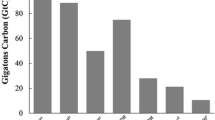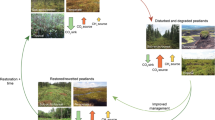Abstract
Tropical peatland ecosystems consider as a key roles not only in the storage of carbon in forests and peat, but also in controlling water resources and in preserving bio-resources and biodiversity. This assessment on peatland definition is intended to adjust existing definition of peatland and further work to improve the existing peatland map that will help identify the gaps amongst various peatland definition. This chapter consists of part, which provides an overview of the importance of peatland both at global and national context, including variety of assessment of peatland contribution to GHG emission.
Based on available references, there are two broad peatland definitions: Authoritative and Scientific. In Indonesia, currently there are three Ministries operate under their own authoritative designations of peatland. The Ministry of Environment of Indonesia defines ‘peat’ as a plant residue formed naturally through long-term decomposition processes, accumulating in swamp areas or static reservoirs. The Ministry of Agriculture defines ‘peat’ as soil formed as a result of organic matter accumulation with a naturally occurring composition of greater than 65 % from the decaying vegetation growing on it, whose decomposition is slowed down by anaerobic and wet conditions. Meanwhile, the Ministry of Forestry defines ‘peat’ as organic matter residue accumulating over a long period of time.
Several scientific definitions have been introduced and acknowledged by scientific communities, including those developed. These definitions are based on field observations and analyses of peat soil properties. Key elements include physical peat properties, such as degree of decomposition (humification), bulk density, water content, porosity and others, and chemical properties, such as carbon content, ash content, pH, and C/N ratio.
Finally, Proposed Peatland Definition of Indonesia is described referencing POLICY MEMO: PEATLAND DEFINITION FROM UNCERTAINTY TO CERTAINTY (Agus Purnomo et al. 2012).
Access this chapter
Tax calculation will be finalised at checkout
Purchases are for personal use only
Similar content being viewed by others
References
Andrejko MJ, Fiene F, Cohen AD (1983) Comparison of ashing techniques for determination of the inorganic content of peats. In: Jarrett PM (ed) Testing of peats and organic soils. American Society for Testing and Materials, Philadelphia, pp 5–20
Arman A (1923) A definition of organic soils- an engineering definition. Engineering Research Bulletin 101. Division of Engineering Research, Louisiana State University. Baton Rouge. University of Toronto Press, 1969, pp 78–126
CSSC (1987) The Canadian system of soil classification. Agriculture Canada Expert Committee on Soil Survey, Ottawa
Davis JH (1946) The peat deposits of Florida: their occurrence, development and uses. Florida Geological Survey Bulletin 30. Tallahassee
DNPI (2010) Report of “Indonesia’s abatement cost curve”. Dewan Nasional Perubahan Iklim, Jakarta
Esterle JS (1990) Trends in petrographic and chemical characteristics of tropical domed peats in Indonesia and Malaysia as analogues for coal formation. PhD thesis, University of Kentucky, Lexington
FAO (1998) World reference base for soil resources. http://www.fao.org/docrep/w8594e/w8594e00.HTM
Hirano T, Segah H, Harada T, Limin S, June T, Hirata R, Osaki M (2007) Carbon dioxide balance of a tropical peat swamp forest in Kalimantan, Indonesia. Glob Chang Biol 13:412–425. doi:10.1111/j. 1365-2486. 2006.01301.x
Hirano T, Jauhiainen J, Inoue T, Takahashi H (2009) Controls on the carbon balance of tropical peatland. Ecosystems 12:873–887
Hooijer A, Silvius M, Wo¨sten H, Page S (2006) PEAT-CO2, assessment of CO2 emissions from drained peatlands in SE Asia. Delft Hydraulics report Q3943, International Wetlands
Jarrett PM (1983) Summary of testing of peats and organic soils. In: Jarrett PM (ed) Testing of peats and organic soils. American Society for Testing and Materials, Philadelphia, pp 233–237
Joosten H, Clarke D (2002) Wise use of mires and peatlands – background and principles including a framework for decision-making. International Mire Conservation Group/International Peat Society, 304 p. http://www.peatsociety.org/sites/default/files/files/WUMP_Wise_Use_of_Mires_and_Peatlands_book.pdf
Kearns FL, Autin WJ, Gerdes RG (1982) Occurrence and stratigraphy of organic deposits, St. Mary Parish, Louisiana. GSA Abstracts With Programs, N.E. and S.E. Sections. Louisiana Geological Survey (LGS), GSA annual meeting, Washington, DC, 30
Kivinen E, Heikurainen L (1979) Classification of peat and peatland. In: Proceedings of international peat society. Finland, IPS
Landva AO, Korpijaakko EO, Pheeney PE (1983) Geotechnical classification of peats and organic soils. In: Jarrett PM (ed) Testing of peats and organic soils. American Society for Testing and Materials, Philadelphia, pp 37–51
Mankinen GW, Gelfer B (1982) Comprehensive use of peat in the U.S.S.R. DOE Fifth Technical Conference on Peat. U.S. Department of Energy, Bethesda, pp 44–54
Moris N (1989) Composition of organic materials of peat soils in Peninsular Malaysia. In: Zauyah S, Wong CB, Paramanathan S (eds) Recent developments in soil genesis and classification, Kuala Lumpur, Malaysia. Malaysian Society of Soil Science, Kuala Lumpur, pp 81–87
Paramananthan S (1998) Malaysian soil taxonomy (second approximation): a proposal for the classification of Malaysian soils. Malaysian Society of Soil Science, Param Agricultural and 278 Soil Surveys (M) Sdn. Bhd., Kuala Lumpur
Purnomo A, Sukadri DS, Helmy F, Osaki M, Hirose K, Mackie C (2012) Policy memo: peatland definition from uncertainty to certainty. ICCC, Jakarta, Indonesia
Ramsar Convention (2013) www.ramsar.org/cda/en/ramsar-documents-texts-convention-on/main/ramsar/1-31-38%5E20671_4000_0__
Soil Survey Staff (1990) US soil taxonomy. Keys to soil taxonomy. Soil Management Support Services Technical Monograph No. 19. Virginia Polytechnic Institute and State University, Blacksburg
Takahashi H, Usup A, Hayasaka H, Limin HS (2003) Estimation of ground water level in a peat swamp forest as an index of peat/forest fire. In: Proceedings of the international symposium on land management and biodiversity in Southeast Asia, Bali Indonesia, September, 2002, pp311–314
Wetland 2013 Supplement (2013) 2013 Supplement to the 2006 IPCC guidelines for national greenhouse gas inventories: wetlands – methodological guidance on lands with wet and drained soils, and constructed wetlands for wastewater treatment – (Wetlands Supplement). http://www.ipcc-nggip.iges.or.jp/home/wetlands.html
Wüst RA, Bustin RM, Lavkulich LM (2003) New classification systems for tropical organic-rich deposits based on studies of the Tasek Bera Basin, Malaysia. Catena 53(2):133–163
Acknowledgement
Results shown in this paper were mainly obtained from SATREPS (Science and Technology Research Partnership for Sustainable Development) project entitled as “Wild fire and carbon management in peat-forest in Indonesia” founded by JST (Japan Science and Technology Agency) and JICA (Japan International Cooperation Agency).
Author information
Authors and Affiliations
Corresponding author
Editor information
Editors and Affiliations
Rights and permissions
Copyright information
© 2016 Springer Japan
About this chapter
Cite this chapter
Osaki, M., Hirose, K., Segah, H., Helmy, F. (2016). Tropical Peat and Peatland Definition in Indonesia. In: Osaki, M., Tsuji, N. (eds) Tropical Peatland Ecosystems. Springer, Tokyo. https://doi.org/10.1007/978-4-431-55681-7_9
Download citation
DOI: https://doi.org/10.1007/978-4-431-55681-7_9
Publisher Name: Springer, Tokyo
Print ISBN: 978-4-431-55680-0
Online ISBN: 978-4-431-55681-7
eBook Packages: Earth and Environmental ScienceEarth and Environmental Science (R0)




